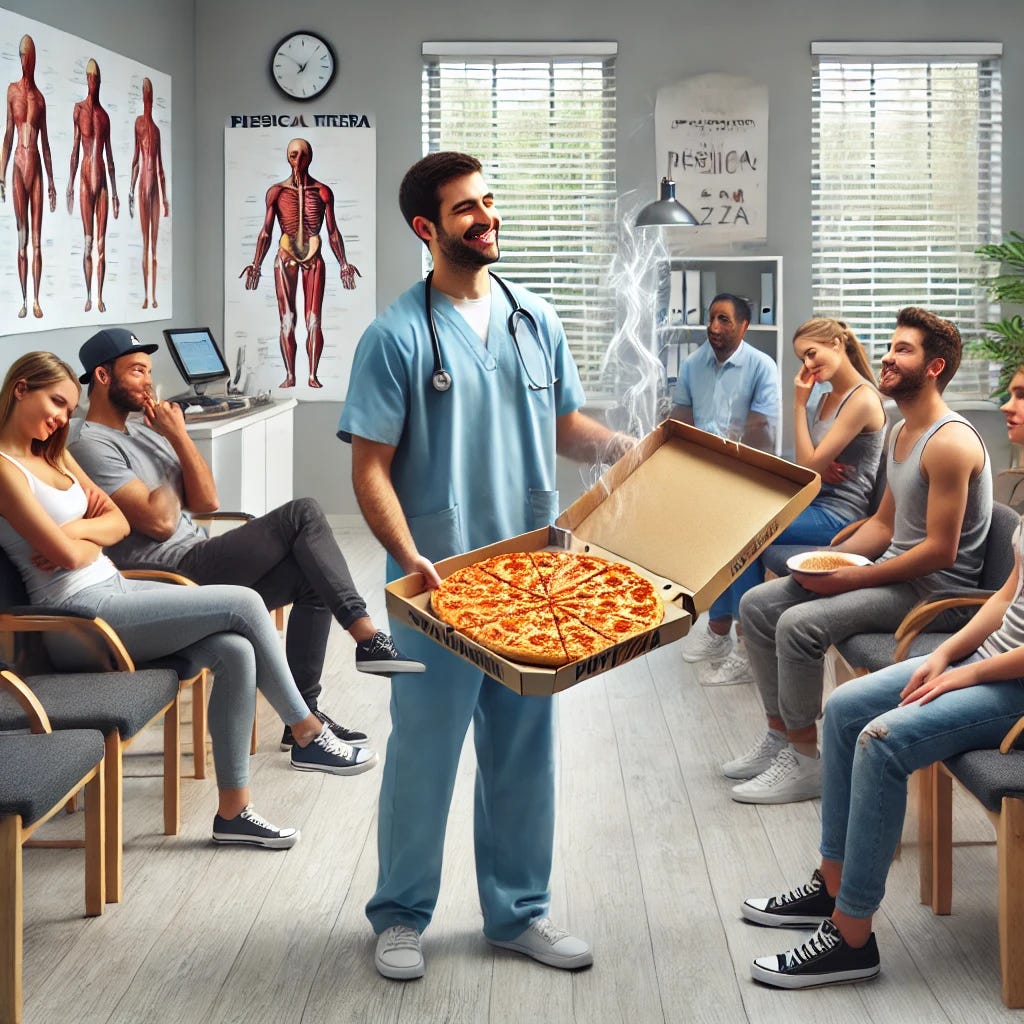The Patient Experience
What Healthcare Can Learn from the Restaurant Business
Have you ever stood in a long line at a restaurant to pick up food or get a table, feeling your frustration rise by the minute? Recently, I found myself in that exact situation at a bustling Italian eatery. The place was packed to the brim, and a line of hungry patrons stretched to the door just to pick up takeout. People were visibly upset and impatient—understandably so, as their stomachs were growling and the wait was longer than expected.
But then, the restaurant staff did something brilliant: they started offering slices of fresh pizza to everyone waiting in line. Suddenly, the grumbling crowd turned into a line of smiling, appreciative customers. Despite the wait still being as long, having that small gesture turned frustration into gratitude, and the atmosphere became more positive almost instantly.
This experience left me thinking: What can physical therapy clinics and other outpatient medical offices learn from this scenario? While you probably won’t be handing out free pizza to your patients (or maybe?), you can adopt the restaurant’s strategy of proactive kindness, empathy, and positive engagement with your staff.
1. Acknowledge the Wait
Sometimes, patients will have to wait—maybe an earlier appointment ran over time, or a new patient needed extra attention. Rather than ignoring it and leaving patients to stew in frustration, have your staff acknowledge the wait. A simple: “I’m sorry for the delay. I’ll be with you shortly,” goes a long way toward helping someone feel seen and valued. In a physical therapy setting where patients may already be in pain or discomfort, recognizing their time and inconvenience is crucial. It doesn’t so much matter what the reason is, so long as they are acknowledged with some reason.
2. Offer Immediate, Tangible Comfort
The Italian restaurant gave out free pizza to ease hunger and tension. While it may not be feasible (or healthy!) to hand out pizza in the waiting room, consider small “comfort” offerings that would make waiting easier. This could be providing fresh lemon water, coffee, a healthy snack (if appropriate), or even something as simple as comfortable seating, quality reading materials, or short educational videos that may be helpful from a therapeutic standpoint. Sometimes, a warm greeting and a personal check-in—“How are you feeling today?”—can also serve as that extra “slice” of kindness.
3. Communicate Clearly and Manage Expectations
The restaurant staff successfully calmed tempers by showing they understood customers’ frustrations. In outpatient practices, managing expectations and communicating timelines can transform patient experience. If there’s going to be a delay, let them know approximately how long it will be and why it’s happening. Share updates: “We’re running about 10 minutes behind schedule.” People are far more patient when they feel informed and included. It sounds obvious, but not always implemented with consistency, and rarely part of staff training.
4. Personal Touch Points
The restaurant’s free pizza wasn’t just about filling empty stomachs; it was an act of empathy that said, “We see you, and we appreciate your time.” In physical therapy or any medical practice, you can craft personal touch points that create the same feeling. Perhaps the front-desk or ancillary staff can spend an extra minute checking on patients’ comfort—how are they feeling that day? How has their condition improved or changed since the last visit? These small gestures help patients feel appreciated, not just a time slot on a schedule.
5. Transform Frustration into Appreciation
Ultimately, the Italian restaurant turned an awkward, tense moment into something special by going above and beyond. In an outpatient physical therapy practice, consider small but meaningful ways to surprise and delight patients. Maybe it’s a follow-up call after a tough session to see how they’re feeling, or a quick congratulatory note when they hit a milestone in their recovery. These genuine, “above-and-beyond” moments can leave a lasting positive impression, just like a slice of hot pizza did for the restaurant’s patrons. The pain point is the opportunity to build the relationship and improve retention and compliance.
Running an outpatient physical therapy practice can feel like a juggling act of scheduling, paperwork, and clinical care. But no matter how busy you are, always remember the power of empathy and thoughtful service. Just as that bustling Italian restaurant turned hungry, frustrated customers into happy, loyal fans, you can transform a stressful wait into an opportunity to show patients that you value them.
By acknowledging their wait, offering comfort, communicating clearly, and adding a personal touch, you’ll cultivate a therapy experience that patients appreciate—and keep coming back for. If you’re a clinic owner or operator, this is something to consider. We all say we want this level of customer service, but how many operators will invest the time, energy, effort, training, and financial resources needed to coach their teams to behave in this manner?



